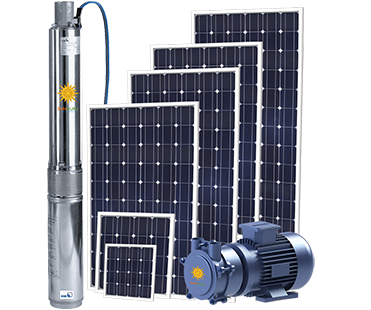
Solar Pump
Efficiency Improvements can be made by using automatic electric sun tracking arrays.
Water Tanks are optional, but enable storage of water for gravity pumping on demand.
Components Pump, controller, solar panels, wiring, piping, water tank
System size depends heavily on site and pumping requirements
Fuel type needed High levels of sunlight
Fuel replaced Diesel, Petrol, Gas
Solar array size 8 – 10 m2 /kW for silicon PV panels
System power 0.4 kW – 20 kW
Typical lift range 5 – 200 m
Typical flow rates10 – 400 m3 /day
Lifetime Pump5 – 10 years, Panel: 25 years
Pumps operate without supervision and require very little maintenance compared to diesel set-ups, however, routine maintenance is necessary to ensure a long lifecycle. This could include checking for faults, the cleaning of panels and pump filters, and the maintenance of the site around the SWP.
The breakeven time of a solar pump against the cost of diesel pumping is typically between 1.5 – 4 years. For instance a pump operating with 50 m lift and flow rates of 20 m3 /day will breakeven after 20 months when compared to a diesel pump running for 5 hours a day with diesel costs of Rs. 80 per litre. As diesel costs continue to increase, and solar pump systems become more affordable, this breakeven point will be reached sooner and savings will be higher.
Brands:
PV Modules: SOLAR WORLD (Produced in Germany)
Submersible Pumps: Elmaksan, Alarco ( Turkey)
Controller: ABB, ADA





